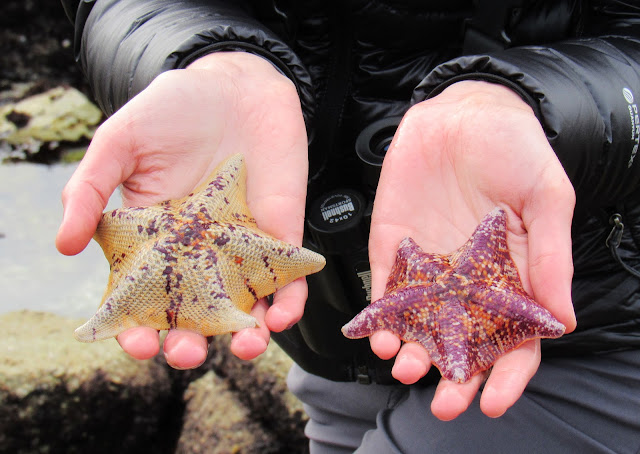Tidepool Treasures: Bat Stars
More commonly known as "starfish," sea stars truly are shining stars of the tidepool. Last week while exploring one of my favorite places, the coast and tidepools around Point Pinos, I was delighted to come across a couple dozen bat stars of all colors and sizes.
Though I still slip up and refer to these beautiful creatures as "starfish" on occasion, sea stars are not fish at all. Having neither fins, scales, gills, or even blood, sea stars are echinoderms (members of the phylum Echinodermata), related to sand dollars, sea urchins and sea cucumbers.
Though sea stars appear quite sessile, or fixed to one spot, they are actually quite mobile, moving along the sea floor and tidepool substrates on hundreds of tiny little suction cup-tipped tube feet. (Check out the photo below for a look at the underside of a bat star.) Holding a sea star in the palm of your hand, it is easy to feel the tiny suctions of its many tube feet.
Residents of kelp forests and the rocky intertidal zone, bat stars are found from Sitka Alaska to Baja California, from tidepools to depths of 950 feet.
I mentioned earlier that sea stars do not have blood, or a typical circulatory system. Rather, they function by making use of a water vascular system, which uses sea water to power an internal hydraulic system responsible for locomotion, food and waste transportation, even respiration.
Sea stars "see" through light-detecting eyespots at the end of each arm, and "smell" through sensors on their tube feet. Their "mouth" is on their underside and waste is excreted through the upper side.
As if that's not bizarre enough, sea stars also employ a neat trick while feeding: they evert their stomach. Literally, a sea star pushes its stomach out of its body, through its mouth, in order to begin digesting its prey externally before pulling it back into its body to complete the process. This adaptation allows sea stars to feed on a variety of plants and animals that would otherwise be too large to fit into their flat bodies. I came across a couple of feeding sea stars during my tidepool wanderings, and thought it best to leave them alone to digest their hard-earned meal. (Feeding sea stars can be distinguished by the body's domed posture.)
Bat stars (and other sea stars) reproduce externally through spawning. Fertilization takes place in the water, resulting in microscopic sea star larvae, which float through the water column as part of that great group at the base of the marine food web, zooplankton. Eventually the larvae settle to the substrate and develop into sea stars.
In 2013-14, an epidemic of startling proportions hit sea star populations up and down the Pacific Coast, from Alaska to Baja California. Known as sea star wasting syndrome, infected sea stars first develop lesions, then progress rapidly to arm detachment, dissolving or "melting," and ultimately death. When infected, the body of a perfectly healthy sea star literally disintegrates within two or three days.
More than twenty species of sea stars along the Pacific Coast are affected by the disease, including the bat star. Species affected most severely include the sunflower star and ochre star.
Scientists are unsure exactly what causes sea star wasting syndrome. Initially, a virus was thought to be the cause, but new research seems to indicate that the virus is just a side effect of larger issues possibly linked to climate change. More research is needed, however, to reach a conclusion.
Check out this site, from UC Santa Cruz, for more information and pictures of infected sea stars.
As scavengers, sea stars are an important part of marine ecosystems, cleaning up the sea floor and keeping it free of dead animals and algae. (Have you ever noticed how sparkling clean healthy tide pools are? For this, thank the scavengers!) The ochre star is considered a keystone predator in intertidal communities, by keeping populations of mussels in check, and the rare sunflower star promotes healthy kelp forests by feeding on sea urchins, which would otherwise decimate kelp stands.
As scavengers, sea stars are an important part of marine ecosystems, cleaning up the sea floor and keeping it free of dead animals and algae. (Have you ever noticed how sparkling clean healthy tide pools are? For this, thank the scavengers!) The ochre star is considered a keystone predator in intertidal communities, by keeping populations of mussels in check, and the rare sunflower star promotes healthy kelp forests by feeding on sea urchins, which would otherwise decimate kelp stands.
It was wonderful to find so many healthy bat stars at Point Pinos. In California, ochre star populations appear to be recovering, however, no sunflower stars have been observed in the state this year. (Check updates here.) Recovery is uncertain and almost certainly slow, and future outbreaks of sea star wasting syndrome are likely.
A word about exploring and protecting fragile tidepool habitats:
- Tread carefully, move slowly, watch where you step, and try to step only on bare rock to avoid crushing animals or slipping on seaweeds.
- Never, ever take living animals or plants from tidepools. Always touch carefully and gently, and put everything back exactly where you found it. Many tidepool creatures are relatively sessile, and took a long time to find that perfect spot you just plucked them from! Life in tidepools is difficult enough; don't put undue stress on the creatures that live there.
- Don't let your trash (or anything else!) fall into tidepools, and remove any human-made material that you find, especially things like plastic bags and fishing line.
- Watch tide charts and wave action; aim for low tide on a calm day. Always be aware of the sea and the incoming tide, listen to the waves and don't turn your back on the ocean!
















Comments
Post a Comment